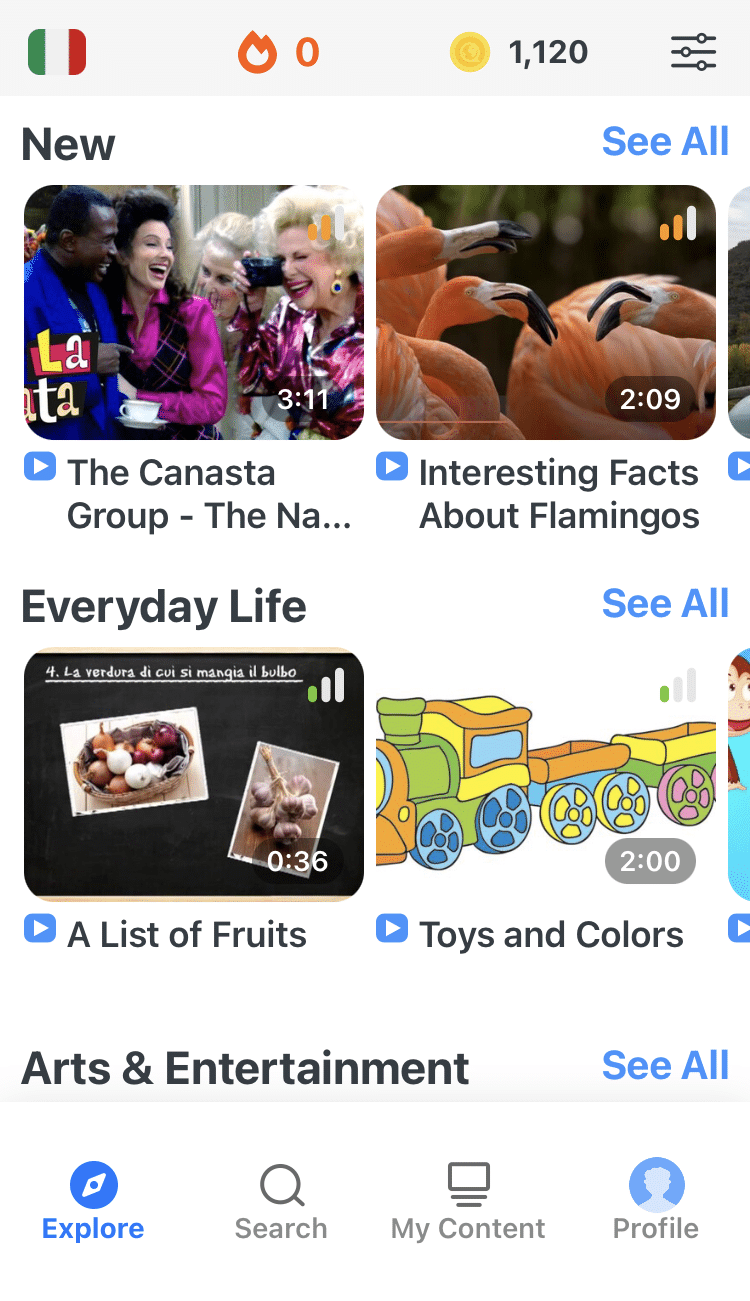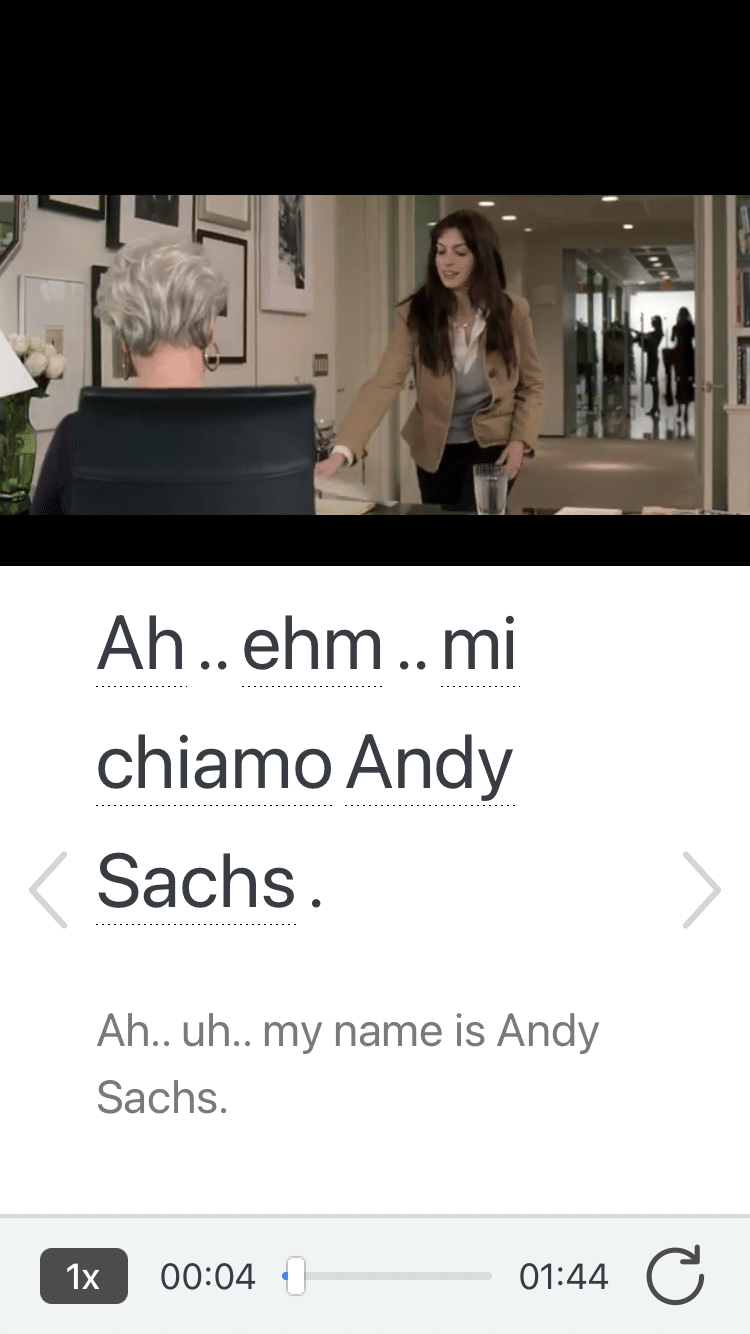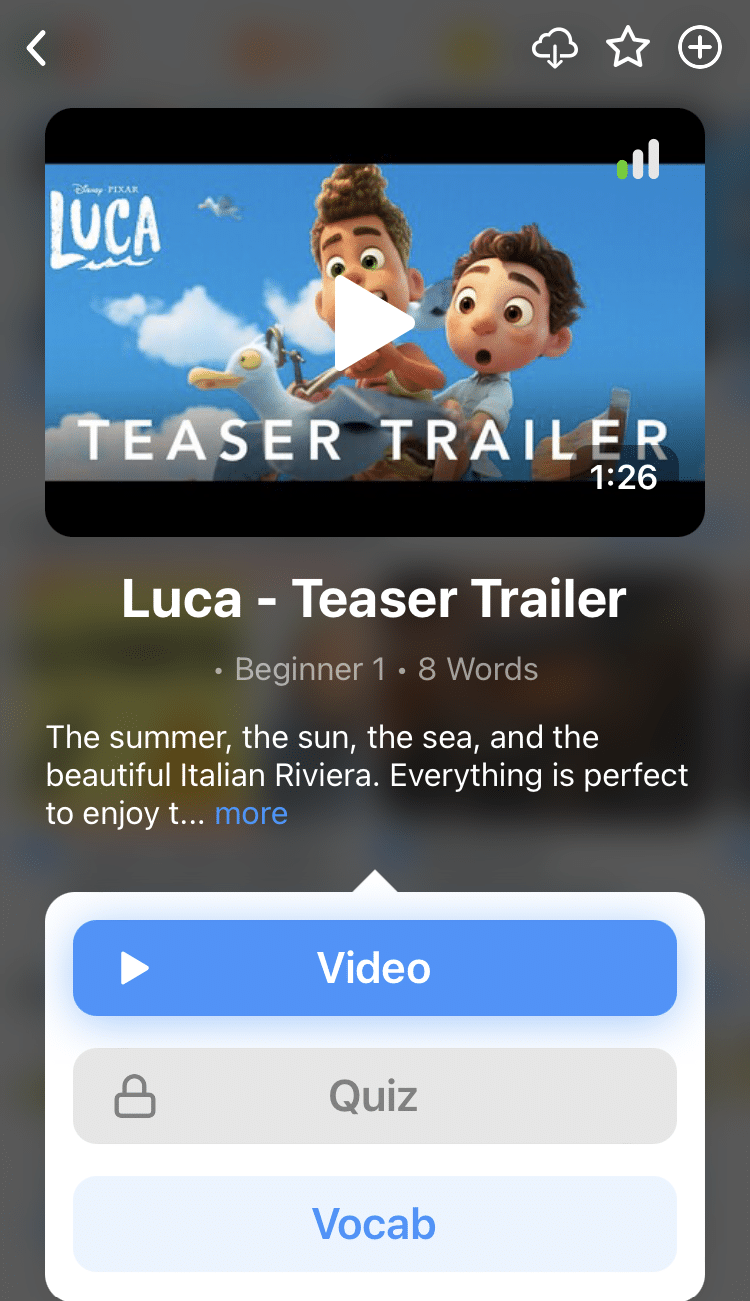
15 Best Italian Movies on Netflix to Watch in April 2024
Italy has a rich artistic culture–and that includes Italian movies. We can thank Italian filmmakers for creating plenty of masterpieces throughout the years and even changing world cinema forever.
Conveniently, you can just log onto Netflix today and get hundreds of Italian films right at your fingertips, from well-known classics to gritty Netflix originals.
Check out our awesome recommendations for Italian movies on Netflix this 2024!
If you’re learning Italian, you can even turn watching movies into study time (and potentially improve your listening a lot).
Contents
- 1. “La vita davanti a sé” (The Life Ahead)
- 2. “Lazzaro felice” (Happy as Lazzaro)
- 3. “Sotto il sole di Riccione” (Under the Riccione Sun)
- 4. “18 Regali” (18 Presents)
- 5. “Slam: Tutto per una ragazza” (Slam)
- 6. “Gli infedeli” (The Players)
- 7. “Natale a 5 stelle” (5 Star Christmas)
- 8. “L’incredibile storia dell’Isola delle Rose” (Rose Island)
- 9. “Sulla mia pelle” (On My Skin: The Last Seven Days of Stefano Cucchi)
- 10. “Il legame” (The Binding)
- 11. “È stata la mano di Dio” (The Hand of God)
- 12. “L’uomo senza gravità” (The Man Without Gravity)
- 13. “Lo spietato” (The Ruthless)
- 14. “Il filo invisibile” (The Invisible Thread)
- 15. “The Tearsmith”
- And One More Thing...
Download: This blog post is available as a convenient and portable PDF that you can take anywhere. Click here to get a copy. (Download)
1. “La vita davanti a sé” (The Life Ahead)
Can you ever get enough Sophia Loren?
The answer is “no,” and that’s why this is the first movie on our list.
Loren stars as Madam Rosa, a Holocaust survivor who runs a brothel in Bari. When the young son of a Senegalese immigrant attempts to rob her, she takes him in, agreeing to care for him while his father is away.
Even though it seems that Madam Rosa sacrifices a lot for the child initially, it turns out that he also has something to offer her, especially as Madam Rosa’s mental state begins to decline.
There’s also the opportunity to learn Italian words related to history, hardship and slang.
2. “Lazzaro felice” (Happy as Lazzaro)
“Lazzaro felice” is a critically-acclaimed Italian movie that’s perfect for viewers who want a little taste of Italian high cinema. It was nominated for the Palme d’Or at the Cannes Film Festival in 2018.
It follows Lazzaro, a young worker on a farm estate, as he befriends the young estate manager to extort money from the estate owner.
When Lazzaro falls down a cliff and wakes up years later without having aged a day, the estate Lazzaro remembers is drastically different.
The acting in this movie is amazing, and the twist at the end is well worth the wait. While the language in this film can be quite advanced and much is implied, there’s ample vocabulary about farm life, friendship and life in general.
3. “Sotto il sole di Riccione” (Under the Riccione Sun)
A teen coming-of-age film, anyone?
Set on the beach (of course!), this movie follows a group of teenagers as they spend their summer in Riccione, a seaside resort town on Italy’s Adriatic coast.
The movie intertwines several storylines of love and friendships, throwing in some healthy doses of heartbreak, drama and tear-jerking romance.
This movie has a modern flair too: it incorporates the phenomena of social media and finding love interests through dating apps.
If you’re looking for a feel-good film that perfectly blends comedy and drama, then “Sotto il sole di Riccione” is a great choice that will help you learn informal Italian and slang as it’s spoken by Italian youth.
4. “18 Regali” (18 Presents)
Based on the true story of an Italian woman named Elisa Girotto, you’re definitely going to need a tissue box handy for this movie.
The movie follows Elisa as the main character. She’s pregnant with a daughter at the age of 40. Before she gives birth to the child, she discovers that she has terminal breast cancer, and she likely won’t live long enough to see her daughter grow up.
To cope with the grief, Elisa decides she’ll collect 18 gifts for her unborn daughter with the intention of her daughter opening one each year until her 18th birthday.
To say that this movie is emotional is an understatement. However, it’s a good one, and its exploration of the themes of love, loss and life is truly stellar.
5. “Slam: Tutto per una ragazza” (Slam)
Tutto per una ragazza means “all for a girl,” and that’s just what Sam thinks he’s sacrificing when he discovers he has gotten his new girlfriend pregnant.
Just as his future as a professional skateboarder seems to be slipping away, he finds support from an unlikely: famous skateboarder Tony Hawk! Okay, well…he doesn’t actually get support from Tony Hawk, but he reads a lot about his skateboarding idol.
This allows him to make decisions that will impact the rest of his life as well as consider how his girlfriend’s life is also being changed by the pregnancy.
This movie is surprisingly lighthearted for the subject matter, and the soundtrack is awesome! Learners can expect to access a lot of vocabulary related to youth, slang and, of course, skateboarding.
6. “Gli infedeli” (The Players)
“Gli infedeli” is a movie that’s pretty much about what the title says: it centers on a number of men who are players, each with their own story of infidelity and relationship drama.
It’s a collection of vignettes, each with its own flavor. Some of the vignettes are dramatic and intense, others sad, and there’s even humor in some of the vignettes. There are also definitely some well-known names starring in this one.
This movie is also a great way to practice romance vocabulary, and a lot of it! With each vignette focusing on its own style of a fractured relationship, learners can find words to express pretty much anything about love and betrayal in Italian.
7. “Natale a 5 stelle” (5 Star Christmas)
Reminiscent of “Weekend at Bernie’s,” this film follows Italian Prime Minister Franco Rispoli who goes on an official diplomatic trip to Budapest during Christmas with his secretary, Guilia Rossi.
While Franco and Giulia are engaging in “official business,” if you catch my drift, they spot a man in a Santa costume dangling from the hotel room’s window. It turns out the man’s dead, and thus begins a farce.
How can Franco and Giulia keep their scandalous relationship secret while disposing of a corpse and as their respective spouses arrive in Budapest?
This funny movie is a great one to grow love vocabulary as well as political and government vocabulary. The humor can also be a little cultural, so some of the jokes may be worth looking into.
8. “L’incredibile storia dell’Isola delle Rose” (Rose Island)
This film is based on the true and strange story of Giorgio Rosa, who literally built his own island off of the coast of Rimini.
Rosa started building the island in 1958. His masterpiece—more of a concrete platform than a typical, land-based island—took nearly a decade to construct.
Rosa, an engineer, provoked the ire of the Italian government when he proclaimed his island an independent state with its own ministers and Esperanto as the official language.
Shortly after the establishment of the Republic of Rose Island in May 1968, Italian police forces made their presence known upon the island. By February of 1969, the island had become but a memory. Now, nearly half a century later, it’s a legend.
9. “Sulla mia pelle” (On My Skin: The Last Seven Days of Stefano Cucchi)
The real-life story of Roman building surveyor Stefano Cucchi is dramatized in this dark film that was written and directed by Alessio Cremonini.
Cucchi was taken into police custody on a drug charge. While he was in custody, Cucchi died as a result of savage beating, a victim of police brutality.
The film is not only the tale of Stefano himself, but also the story of how his family fought to find the truth and bring justice to Stefano’s memory.
This work was honored with four Premi David di Donatello (David di Donatello Awards) from the Accademia del Cinema Italiano (Italian Cinema Academy), including one for Best Actor (Alessandro Borghi) and Best Début Director (Alessio Cremonini).
10. “Il legame” (The Binding)
Are you in the mood for a scary movie? At first glance, “Il legame” seems like your typical horror fare. But wait! It’s more than that.
While visiting her soon-to-be husband’s family in southern Italy, Emma finds out that her daughter has been “bound” to an evil spirit who wants nothing but to claim the little girl as its own.
Throw in some jump scares, creepy music and a pretty good twist at the end, and this movie is much more than just a scary flick.
This movie is also good for learning vocabulary related to family and the occult—if you’re into that sort of thing! It’s not for the faint of heart, of course, but it could give your Italian a little jolt.
11. “È stata la mano di Dio” (The Hand of God)
This quiet coming-of-age film, set in Naples in the 1980s, is directed by Paolo Sorrentino and is based on his own life experiences. It won the Grand Jury Prize at the 78th Venice International Film Festival and several other awards.
The main character, Fabietto, is preoccupied with girls and soccer, when, halfway through the film, his family experiences a tragedy which turns his life upside down.
He’s forced to grow up quickly and reflect on how he wants to live his life moving forward.
Beside referring to the elements of life out of our control, the title also refers to the famous soccer player, Diego Maradona, and his infamous goal against England in the 1986 World Cup.
12. “L’uomo senza gravità” (The Man Without Gravity)
After the melancholic feels of many of the movies on this list, here is a beautiful modern day fairy tale film filled with magical realism, about a man who’s not weighed down by gravity.
Oscar is born floating and needs a special backpack to keep him on the ground. His mother and grandmother make him keep it a secret and he grows up isolated and sheltered.
Only one person finds out his secret while he’s a child, and that is his friend Agata. Once he becomes an adult, he decides to run away and share his secret with the whole world.
You’ll come across language about family relationships, friendship and fame in this film so get ready to improve your Italian vocabulary in those topics.
13. “Lo spietato” (The Ruthless)
Well, there needed to be at least one mafia movie in here. But just one, as there is so much Italian film has to offer beyond gangster movies!
The story follows Santo Russo and his rise to becoming a prominent mobster around the height of criminal activity in Milan during the 1980s and 1990s.
The main character is based on the real-life mafia boss Saverio Marobito, who eventually became a police informant later on in his life.
If you’re a fan of classics such as Goodfellas and Scarface, then this might be right up your alley. There will be a lot of familiar themes, but the soundtrack, the aesthetics, the acting and comedic elements will make it worth it!
14. “Il filo invisibile” (The Invisible Thread)
This one is a family comedy drama that follows a teenage boy, Leone, who decides to film a documentary about his two dads for a school class.
While filming his school project, there’s an unexpected turn of events and Leone’s biological parentage is brought into question.
The film shows the prejudice the family experiences and shows all the ways their family is different and the same as other families. It’s also filled with family drama and a coming-of-age aspect as Leone falls in love with a girl from his school.
If you’re in the mood for a more feel-good movie, definitely give this one a go!
15. “The Tearsmith”
This Netflix original is a new Italian romance drama based on a novel by author Erin Doom.
Nica and Rigel grew up together as orphans and were fortunately adopted by the same family. But as they turn 17 years old, they realize their deep bond might be something more than friends, and that they might have developed romantic feelings for each other.
The movie takes you on their journey of discerning their complicated pasts, feelings and relationship. And it also dives into the Tearsmith—a mysterious entity that’s responsible for fear—an Italian legend they grew up hearing about in the orphanage.
With all these Italian films so readily available, you can go on a movie binge anytime. Netflix has plenty of Italian series too!
If you’re learning Italian, watching movies and shows is one of the most effective (and fun) ways to immerse in the culture while improving your Italian. For instance, the FluentU program bases its lessons on Italian movie clips and other engaging videos.
FluentU takes authentic videos—like music videos, movie trailers, news and inspiring talks—and turns them into personalized language learning lessons.
You can try FluentU for free for 2 weeks. Check out the website or download the iOS app or Android app.
P.S. Click here to take advantage of our current sale! (Expires at the end of this month.)
Whether you’re watching Italian movies for entertainment or learning, go select a film from the list above and enjoy!
Download: This blog post is available as a convenient and portable PDF that you can take anywhere. Click here to get a copy. (Download)
And One More Thing...
If you're as busy as most of us, you don't always have time for lengthy language lessons. The solution? FluentU!
Learn Italian with funny commericals, documentary excerpts and web series, as you can see here:

FluentU helps you get comfortable with everyday Italian by combining all the benefits of complete immersion and native-level conversations with interactive subtitles. Tap on any word to instantly see an image, in-context definition, example sentences and other videos in which the word is used.

Access a complete interactive transcript of every video under the Dialogue tab, and review words and phrases with convenient audio clips under Vocab.

Once you've watched a video, you can use FluentU's quizzes to actively practice all the vocabulary in that video. Swipe left or right to see more examples of the word you’re on.

FluentU will even keep track of all the Italian words you’re learning, and give you extra practice with difficult words. Plus, it'll tell you exactly when it's time for review. Now that's a 100% personalized experience!
The best part? You can try FluentU for free with a trial.
Start using the FluentU website on your computer or tablet or, better yet, download the FluentU app from the iTunes or Google Play store. Click here to take advantage of our current sale! (Expires at the end of this month.)



